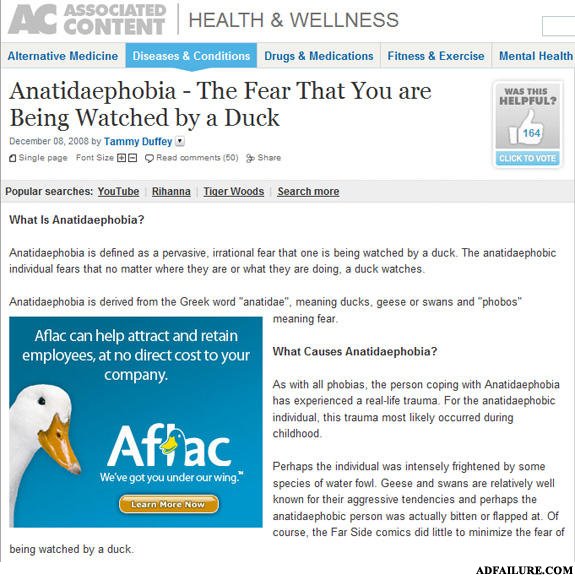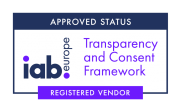
In essence, Brand Safety is a set of techniques that help advertisers keep a brand’s reputation clean and shiny. In the context of programmatic advertising that means avoidance of bad ad placements at any cost.
Why is it so important? Here’s an example:

Source: adfailure.com
Just look at this ad and the editorial context it is in. Imagine you are someone with anatidaephobia looking for practical information on your phobia. After some time spent searching the web, you land on this page. A creepy duck is peeking right at you from the screen of your computer. This is definitely not the best page for such an ad. The potential customer turns her back on you and sees the brand as a bad omen.
This is probably one of the best examples of bad ad placement and inappropriate editorial context. After a number of similar incidents, brands are very careful about digital ad space they buy.
What Advertisers Do Not Want
The days when advertisers blindly paid for whatever ad space is available are long gone. Today, buyers scrupulously choose from available ad placements. They stay away from everything that is illegal, offensive, or just not really related to the product they are promoting. Basically, they avoid everything that is listed by the IAB, which is:
- Adult Content
- Facilitation of Illegal Activities
- Controversial Subjects (Unconventional Lifestyles and Religions, etc.)
- Copyright Violation
- Drugs/Alcohol/Controlled Substances
- Extreme Violence
- Incentivized Manipulation of Measurements
- Hate/Profanity
- Nuisance/Spyware/Malware/Warez
- Political/Religion
- Unmoderated User Generated Content
This list is non-exhaustive. Brands still can turn down certain websites if they feel like it does not match their campaigns.
Other Examples of Inappropriate Editorial Content
Even if a publisher website does not fall into the IAB list, it still can be inappropriate for an advertiser. Yes, that’s complicated.
But think about this: you’re a devoted yogi and vegetarian searching for new plant-based recipes to diversify your diet. You successfully located the right website but there’s one thing that creeps you out. Sausages and steak ads! How disturbing!

While both the site and ad are in the “food” category, not all readers will be happy to see them together.
There is only one way to avoid this type of situations (unless you’re not involved in direct buying). Use blacklists and negative keywords. By restricting certain sites and keywords you don’t want to be associated with your product, you will find the safe environment for ads that will generate positive associations with your brand.
What Else to Take into Consideration
When choosing the best placements, brands think about the audience they want to reach, the adjacency of the editorial content and mood it generates. If the context sends a negative message, probably an ad is also going to be associated with something gloomy. That means that the environment equals advertising effectiveness.
Regular readers perceive a premium publisher as a friend they can trust. So, when the publisher advises something, readers are more likely to consider the suggested product.
However, editorial content cannot work out its magic without a good, attention-grabbing creative. If an ad is not good enough, it doesn’t really matter if the editorial is of premium or mediocre quality. It won’t yield results.
Do Ad Networks Filter Out Content Categories?
Ad Networks scan content to sort out inappropriate sites. Additionally, depending on the campaign, a network can embed a code, which will look for the most relevant placements in real time.
Needless to say, reliable sellers would never hijack the success of advertising campaigns by placing ads on sites with controversial content. It’s their work to guarantee advertisers the best results and high conversion rates.
Here, at Impactify, we take brand safety seriously. All publishing partners are carefully chosen in accordance with the IAB guidelines. We use tools such as DoubleVerify and Forensiq IQ to control media quality and provide our partners with the best ad context.
Our main requirement is positive, good-quality content that is of interest to all advertising parties. If you are looking for the safe environment to put your ads in, contact us so we can develop the best strategy for your business goals.

